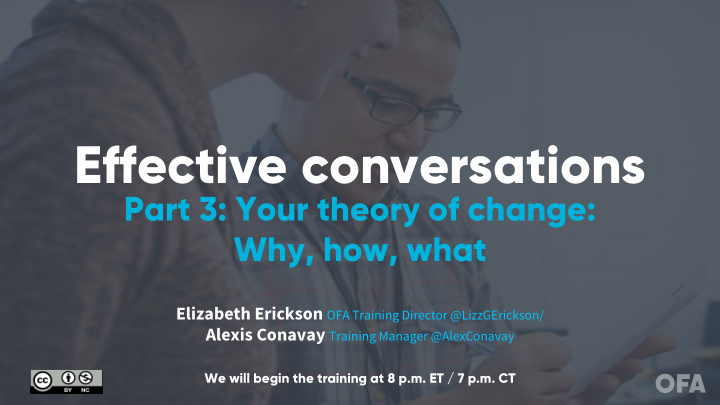



Effective conversations Part 3: Your theory of change: Why, how, what Elizabeth Erickson OFA Training Director @LizzGErickson/ Alexis Conavay Training Manager @AlexConavay We will begin the training at 8 p.m. ET / 7 p.m. CT
GUIDED WORKSHEET Indicators for why, how, and what Bit.ly/why2what
Learning series Week 1: Effective listening Week 2: Know your ‘why’ Week 3: Your theory of change Week 4: Motivational interviewing Week 5: Voter contact best practices
#OFAction
Your theory of change
GOAL FOR THIS SESSION Feel confident using the ‘why, how, what’ framework to talk to your neighbors
Agenda Recap – Knowing your why Why, how, what (and when to use it) Close and next steps
Your why 1 This is your cause, your purpose, your belief. The thing that drives you most. We are able to connect to each 2 other more deeply through values and beliefs. This is the hardest part of ourselves 3 to understand clearly.
Your how 1 This is your strategy, the way that you bring your “why” into being. Your how should explain the way in 2 you which you or your organization live out your values. We sometimes call this our “theory 3 of change.”
Your what 1 Your what is what you do; the actions you take each day. This is the easiest part of ourselves 2 to understand, but the least convincing to motivate others. Use your “why” and “how” to 3 motivate people to join your “what!”
Recap: the framework of your why Critical What is a critical incident that leads to what you believe and incident why? What values are present underneath your critical incident and Values why? How will you practice communicating your values in way that Practice resonates with diverse groups of people?
QUESTION 1: What is Steve Jobs’ why?
QUESTION 2: What values are underneath his why?
QUESTION 3: How does he communicate it? Does it resonate?
You have to understand your why and be genuinely curious about your neighbor’s why.
It’s not enough to know your why—you have to identify a how, and then your what.
Agenda Recap – Knowing your why Why, how, what (and when to use it) Close and next steps
SCENARIO 1 Conversation with someone you’re not politically aligned with
This could • A dinner or happy hour with friends, family, and colleagues happen during… • Canvassing or phonebanking • At work or school during lunch
Stay with why
3 minutes If you were different politically: Reflection • What about my ‘why’ resonates with you? • What questions would you ask me? • How would you use my why if you were talking with me?
Things to • What is their cause? figure out • What is their belief? • Why do they do what they do?
Things to • Your belief communicate • Your cause • Your why
You know to stay with why when you don’t know their values…
... or you haven’t fully communicated your own.
SCENARIO 2 Conversation with someone you are politically aligned with, but you believe change happens differently.
This could • Conversations with close friends happen • Working with partner organizations in the during… progressive community • When you speak to folks who have similar views, but don’t believe change can happen through our democracy • You find someone didn’t vote in their local election • Canvassing or even volunteering with other people
Align with why, move to how
• What about the ‘how’ resonates with you? 3 minutes Reflection • If you believed politically like me, what would you be curious about in my belief of how change happens?
Things to figure • How do they believe change happens? out for “how” • How can you communicate to them how change happens?
”How” is the strategy for bringing your “why” into being.
SCENARIO 3 Conversation with someone you are politically aligned with, and typically think change happens the same way.
This could • Your fellows cohort, campus groups, chapter meeting happen during… • During book club • In your place of worship • Digitally • At your city council meeting
Align with why, move to how, end with what
3 minutes • How do you feel seeing it all together? Reflection • Are you compelled by what she is asking you to do?
Things to figure • What can you ask them to do or join? out for “what” • If they were to do this action, what would happen?
GUIDED WORKSHEET Indicators for why, how, and what Bit.ly/why2what
Let’s practice
Agenda Recap – Knowing your why Why, how, what (and when to use it) Close and next steps
Debrief Wh Whic ich ph phas ase o of th f the fr fram amework c comes e eas asily ily to to you? you? Wh Whic ich te techniqu ique do do y you r respo pond m d most w t well to ll to?
Debrief Wh What ty t types es of of or organiz izin ing d do y o you ou se see th this is f framew ewor ork f k fittin itting in into? to?
And finally… With November 2018 coming up, in what ways will you apply this framework to your own work?
Next session
Effective conversations Part 4: Motivational interviewing June 20 at 8 p.m. ET/7 p.m. CT
Team ’18 ofa.bo/team18lead
OFA Thank you for joining today’s training. Please fill out the survey below and give us your feedback on today’s training. bit.ly/effectiveconvo_WHW
Recommend
More recommend